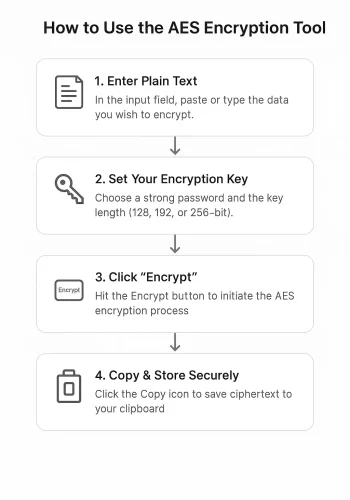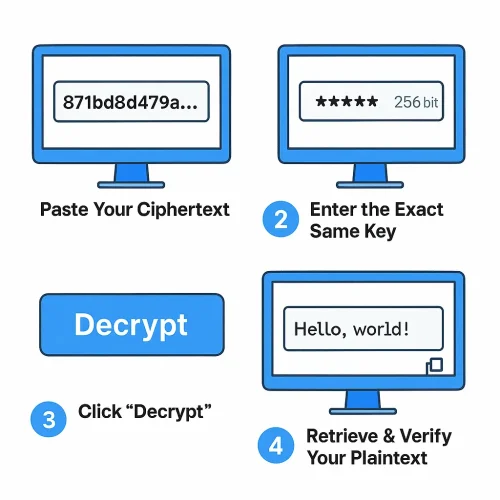- EMI Calculator
- Mortgage Calculator
- BMI Calculator
- Pregnancy Due Date Calculator
- Age Calculator
- AES Encryption and Decryption Online
- DES Encryption & Decryption
- Random Animal Generator
- Random Name Generator
- Random Bible Verse
- Random Number Generator
- Random Noun Generator
- Random Password Generator
- Integration
- Knowledge
- Technical
- Product
- Uncategorized
- Education
- Research
- Astronomy
- Motivation
- Instatech
- Engineering
- Technology
- Business
- Startup
- Money
- Electronics
- Marketing
- Innovation
- Hot
- Gadgets
- Design
- Mindset
- Programming
- Success
- Entrepreneur
- Lifestyle
- Quotes
- Entertainment
- Nature
- Music
- Comedy
- Dance
Introducing AI for customer service
Powerful AI that takes care of your daily tasks. Stop manually processing your text, document, and image data. Let AI work its magic, without a single line of code.
Top Stories
AES Encryption & Decryption
Our free, browser‑based AES Encryption tool transforms your text or files into secure ciphertext within milliseconds, while the intuitive AES Decryption feature instantly restores your original content. Simply paste your data, choose a strong key, and click—no advanced setup or technical expertise needed to achieve enterprise‑grade AES encryption and decryption.
AES Decryption
Decrypted Text
Settings & Actions
What Is AES Encryption?
Advanced Encryption Standard (AES) is a highly secure, symmetric block cipher algorithm that the U.S. National Institute of Standards and Technology (NIST) adopted in 2001 to protect sensitive government and commercial data. As a symmetric key algorithm, AES uses the same secret key for both AES Encryption and AES Decryption, ensuring fast, reliable data protection for everything from text messages to large file transfers.
Key Technical Details:
Block Size: Processes data in fixed 128‑bit blocks, optimizing throughput and parallel processing.
Key Lengths: Supports three key sizes—128, 192, and 256 bits—to balance performance and security. Longer keys provide exponentially stronger resistance against brute‑force attacks.
Rounds: Performs 10, 12, or 14 encryption rounds (depending on key length) of substitution, permutation, mixing, and key‑addition operations to thoroughly scramble plaintext into ciphertext.
Why AES Encryption Is Ideal for Secure Data:
Robust Security: AES has withstood rigorous cryptanalysis for over two decades and remains the industry standard for protecting classified and private information.
High Performance: Designed for high-speed execution in both hardware and software, AES can encrypt or decrypt gigabytes of data per second, making it perfect for real‑time applications.
Cross‑Platform Compatibility: Native support in virtually all modern operating systems, programming languages, and web browsers ensures seamless integration into desktop, mobile, and cloud‑based solutions.
Scalable Strength: Users can choose 128‑bit for everyday encryption needs, or upgrade to 192‑ or 256‑bit keys when handling highly sensitive data like financial records or health information.
By understanding these core features—block size, key length, and processing rounds—developers and end users alike can appreciate why AES Encryption remains the gold standard for securing digital communications and stored data.
How to Use the AES Encryption Tool
Performing AES Encryption with our online tool is a straightforward, four‑step process designed for maximum security and ease of use. Follow these steps to transform your plain text into high‑strength ciphertext instantly:

1. Enter Plain Text
In the input field, paste or type the message, document excerpt, or data you wish to encrypt.
Our AES Encryption tool supports any UTF‑8 text, ensuring compatibility with all languages and special characters.
2. Set Your Encryption Key
Choose a strong, memorable password to use as your AES key.
Select your desired key length: 128‑bit, 192‑bit, or 256‑bit. Longer keys (256‑bit) deliver higher resistance against brute‑force attacks, making them ideal for highly sensitive data.
Tip: Use a mix of uppercase letters, lowercase letters, numbers, and symbols for maximum key strength.
3. Click “Encrypt”
Hit the Encrypt button to initiate the AES Encryption process.
Our tool performs multiple encryption rounds (10 for 128‑bit, 12 for 192‑bit, or 14 for 256‑bit keys), converting your plaintext into secure ciphertext in milliseconds.
You’ll see the output immediately in the ciphertext box.
4. Copy & Store Securely
Click the Copy icon next to your ciphertext to save it to your clipboard.
Store both the ciphertext and your AES key in a secure location—such as a password manager or encrypted vault—so you can decrypt later with confidence.
By following these simple steps, you leverage the full power of AES Encryption—the industry‑standard cipher trusted by governments and enterprises worldwide—to protect your confidential information online.
How to Use the AES Decryption Tool
Decrypting your data with our AES Decryption tool is just as simple and secure as encrypting it. Follow these detailed steps to convert ciphertext back into readable plaintext:

1. Paste Your Ciphertext
In the decryption input field, paste the entire encrypted string you received earlier.
Ensure you include every character—even a single missing or extra character can cause decryption to fail or produce gibberish.
2. Enter the Exact Same Key
Type the same strong password (AES key) you used during encryption.
Choose the matching key length option (128‑bit, 192‑bit, or 256‑bit). The tool must use identical key parameters to reverse the AES rounds correctly.
3. Click “Decrypt”
Press the Decrypt button to initiate the AES Decryption process.
Our tool will perform the reverse sequence of substitution, permutation, mixing, and key‑addition operations—exactly the mirror of the encryption rounds. This happens in milliseconds.
4. Retrieve & Verify Your Plaintext
Your original text will appear instantly in the output box.
Click the Copy icon to save the decrypted plaintext.
Always verify the content integrity—compare a known snippet or checksum if available to confirm decryption accuracy.
Important: AES decryption relies entirely on using the correct key. If you lose or forget the key, your ciphertext cannot be converted back, making your data permanently inaccessible. Store your AES key securely in a trusted password manager or encrypted vault to ensure you can decrypt whenever needed.
Key Features of Our AES Encryption & Decryption Tool
-
Free & Online Access
Experience hassle‑free AES Encryption and AES Decryption without any registration, downloads, or hidden fees. Instantly secure your data from any browser—desktop or mobile. -
Customizable Key Strength
Choose the level of protection that fits your needs. Our tool supports 128‑bit, 192‑bit, and 256‑bit AES Encryption, giving you the flexibility to balance speed and security. -
Instant Processing
Whether you’re encrypting sensitive messages or decrypting files, our optimized AES engine delivers results in milliseconds. Protect or restore your data faster than ever. -
User‑Friendly Interface
Navigate with ease using our clean, intuitive layout. All encryption and decryption controls are clearly labeled—no technical expertise required to perform robust AES Encryption or AES Decryption. -
Zero Data Retention
Your privacy is our priority. We never store your plaintext, ciphertext, or keys on our servers. All AES Encryption and Decryption operations happen client‑side, ensuring complete data confidentiality.
Why Choose Our AES Encryption & Decryption Tool?
-
Complete Security from End to End
Implement industry‑standard AES Encryption to safeguard your confidential information. Our AES Decryption process reverses the algorithm securely, so only you with the correct key can access your data. -
100% Free & Cost‑Effective
Enjoy enterprise‑grade AES Encryption and AES Decryption without any subscription or paywalls. Our fully free tool delivers premium protection at zero cost. -
No Software Installation Required
Access AES Encryption and Decryption whenever you need—directly in your web browser. Our solution works across Windows, macOS, Linux, Android, and iOS. -
Mobile‑Friendly & Responsive Design
Use our AES tool on the go. The responsive layout adapts seamlessly to smartphones and tablets, letting you encrypt or decrypt data from anywhere.
Frequently Asked Questions (FAQs)
- Paste or type your data in the input box.
- Choose a key length (128, 192, or 256 bit) and enter your secret key.
- Click “Encrypt” to generate ciphertext or “Decrypt” to restore plaintext.
- 128 bit: Fastest, suitable for everyday data.
- 192 bit: Stronger, moderate speed.
- 256 bit: Maximum security, slight performance trade‑off.
- Missing or extra characters in the input ciphertext.
- Incorrect key or mismatched key length selection.
- Whitespace or line breaks unintentionally inserted.
- Open the tool page in your browser while online.
- Save the page (Ctrl+S) for offline use.
- Decrypt your saved ciphertext and key any time without a network.
- Use a reputable password manager or encrypted vault.
- Avoid writing keys in plain text or sharing them over insecure channels.
- Rotate keys periodically and back up securely.
